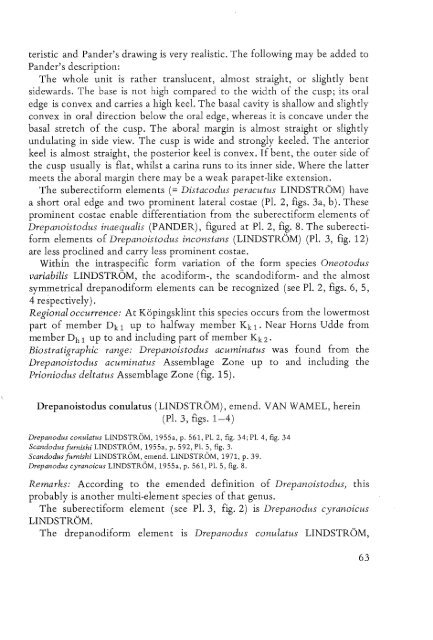UTRECHT MICROPALEONTOLOGICAL BUllETINS
UTRECHT MICROPALEONTOLOGICAL BUllETINS
UTRECHT MICROPALEONTOLOGICAL BUllETINS
You also want an ePaper? Increase the reach of your titles
YUMPU automatically turns print PDFs into web optimized ePapers that Google loves.
teristic and Pander's drawing is very realistic. The following may be added to<br />
Pander's description:<br />
The whole unit is rather translucent, almost straight, or slightly bent<br />
sidewards. The base is not high compared to the width of the cusp; its oral<br />
edge is convex and carries a high keel. The basal cavity is shallow and slightly<br />
convex in oral direction below the oral edge, whereas it is concave under the<br />
basal stretch of the cusp. The aboral margin is almost straight or slightly<br />
undulating in side view. The cusp is wide and strongly keeled. The anterior<br />
keel is almost straight, the posterior keel is convex. If bent, the outer side of<br />
the cusp usually is flat, whilst a carina runs to its inner side. Where the latter<br />
meets the aboral margin there may be a weak parapet-like extension.<br />
The suberectiform elements (= Distacodus peracutus LINDSTROM) have<br />
a short oral edge and two prominent lateral costae (PI. 2, figs. 3a, b). These<br />
prominent costae enable differentiation from the suberectiform elements of<br />
Drepanoistodus inaequalis (PANDER), figured at PI. 2, fig. 8. The suberectiform<br />
elements of Drepanoisto dus inconstans (LINDSTROM) (PI. 3, fig. 12)<br />
are less proclined and carry less prominent costae.<br />
Within the intraspecific form variation of the form species Oneotodus<br />
variabilis LINDSTROM, the acodiform-, the scandodiform- and the almost<br />
symmetrical drepanodiform elements can be recognized (see PI. 2, figs. 6, 5,<br />
4 respectively).<br />
Regionaloccurrence: At Kopingsklint this species occurs from the lowermost<br />
part of member Dk 1 up to halfway member Kk 1. Near Horns Udde from<br />
member Dh 1 up to and including part of member Kk 2.<br />
Biostratigraphic range: Drepanoistodus acuminatus was found from the<br />
Drepanoistodus acuminatus Assemblage Zone up to and including the<br />
Prioniodus deltatus Assemblage Zone (fig. 15).<br />
Drepanoistodus<br />
conulatus (LINDSTROM), emend. VAN WAMEL, herein<br />
(PI. 3, figs. 1-4)<br />
Drepanodus conulatus LINDSTROM, 1955a, p. 561, PI. 2, fig. 34; PI. 4, fig. 34<br />
Scandodus furnishi LINDSTROM, 1955a, p. 592, PI. 5, fig. 3.<br />
Scandodus furnishi LINDSTROM, emend. LINDSTROM, 1971, p. 39.<br />
Drepanodus cyranoicus LINDSTROM, 1955a, p. 561, PI. 5, fig. 8.<br />
Remarks: According to the emended definition of Drepanoistodus, this<br />
probably is another multi-element species of that genus.<br />
The suberectiform element (see PI. 3, fig. 2) is Drepanodus cyranoicus<br />
LINDSTROM.<br />
The drepanodiform element is Drepanodus conulatus LINDSTROM,
















